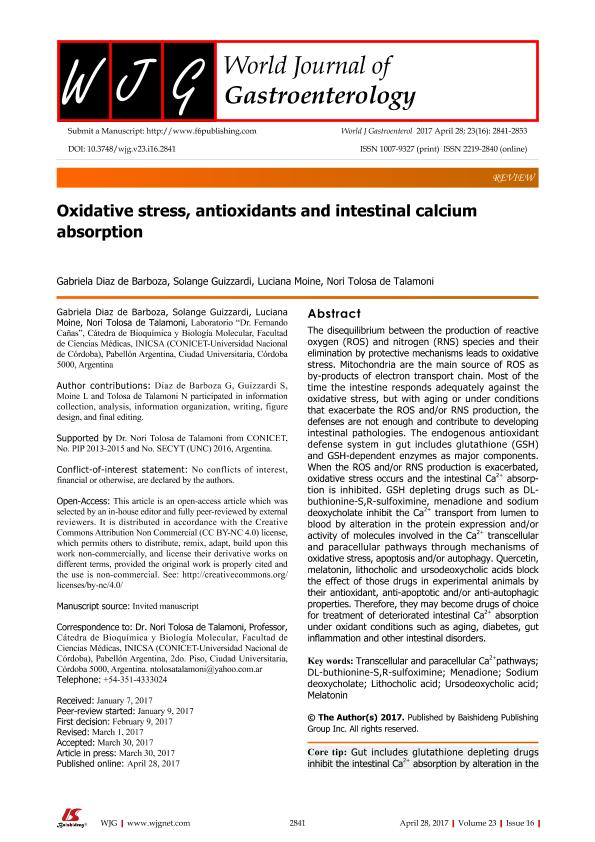Artículo
Oxidative stress, antioxidants and intestinal calcium absorption
Díaz de Barboza, Gabriela Edith; Guizzardi, Solange Natali ; Moine, Luciana Beatriz
; Moine, Luciana Beatriz ; Tolosa, Nori Graciela
; Tolosa, Nori Graciela
 ; Moine, Luciana Beatriz
; Moine, Luciana Beatriz ; Tolosa, Nori Graciela
; Tolosa, Nori Graciela
Fecha de publicación:
04/2017
Editorial:
W J G Press
Revista:
World Journal of Gastroenterology
ISSN:
1007-9327
e-ISSN:
2219-2840
Idioma:
Inglés
Tipo de recurso:
Artículo publicado
Clasificación temática:
Resumen
The disequilibrium between the production of reactive oxygen (ROS) and nitrogen (RNS) species and their elimination by protective mechanisms leads to oxidative stress. Mitochondria are the main source of ROS as by-products of electron transport chain. Most of the time the intestine responds adequately against the oxidative stress, but with aging or under conditions that exacerbate the ROS and/or RNS production, the defenses are not enough and contribute to developing intestinal pathologies. The endogenous antioxidant defense system in gut includes glutathione (GSH) and GSH-dependent enzymes as major components. When the ROS and/or RNS production is exacerbated, oxidative stress occurs and the intestinal Ca2+ absorption is inhibited. GSH depleting drugs such as DLbuthionine-S,R-sulfoximine, menadione and sodium deoxycholate inhibit the Ca2+ transport from lumen to blood by alteration in the protein expression and/or activity of molecules involved in the Ca2+ transcellular and paracellular pathways through mechanisms of oxidative stress, apoptosis and/or autophagy. Quercetin, melatonin, lithocholic and ursodeoxycholic acids block the effect of those drugs in experimental animals by their antioxidant, anti-apoptotic and/or anti-autophagic properties. Therefore, they may become drugs of choice for treatment of deteriorated intestinal Ca2+ absorption under oxidant conditions such as aging, diabetes, gut inflammation and other intestinal disorders.
Archivos asociados
Licencia
Identificadores
Colecciones
Articulos(INICSA)
Articulos de INSTITUTO DE INVESTIGACIONES EN CIENCIAS DE LA SALUD
Articulos de INSTITUTO DE INVESTIGACIONES EN CIENCIAS DE LA SALUD
Citación
Díaz de Barboza, Gabriela Edith; Guizzardi, Solange Natali; Moine, Luciana Beatriz; Tolosa, Nori Graciela; Oxidative stress, antioxidants and intestinal calcium absorption; W J G Press; World Journal of Gastroenterology; 23; 16; 4-2017; 2841-2853
Compartir
Altmétricas



